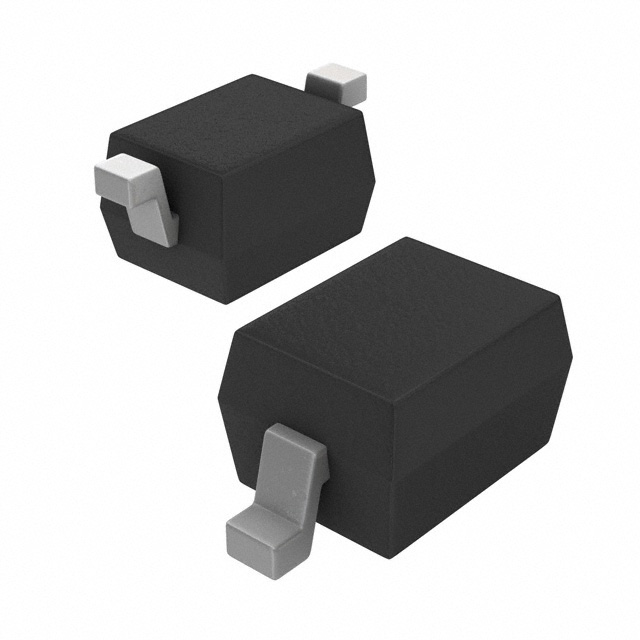Xem thông số kỹ thuật để biết chi tiết sản phẩm.

BZT52C3V3S-7: Product Overview and Analysis
Introduction
The BZT52C3V3S-7 is a crucial component in the field of electronics, belonging to the category of voltage regulator diodes. This entry will provide an in-depth overview of this product, covering its basic information, specifications, pin configuration, functional features, advantages and disadvantages, working principles, application field plans, and alternative models.
Basic Information Overview
- Category: Voltage Regulator Diodes
- Use: Voltage regulation in electronic circuits
- Characteristics: Low power loss, compact size, high reliability
- Package: SOD-323
- Essence: Zener diode for voltage regulation
- Packaging/Quantity: Available in reels with varying quantities
Specifications
- Voltage: 3.3V
- Power Dissipation: 300mW
- Forward Voltage: 0.9V
- Reverse Current: 5μA
- Operating Temperature Range: -65°C to +150°C
Detailed Pin Configuration
The BZT52C3V3S-7 follows the standard SOD-323 package configuration, with the anode connected to one end and the cathode to the other.
Functional Features
- Voltage Regulation: Provides stable 3.3V output under varying input conditions
- Overvoltage Protection: Safeguards downstream components from excessive voltage
- Compact Design: Ideal for space-constrained applications
Advantages and Disadvantages
Advantages
- Precise voltage regulation
- Compact size
- High reliability
Disadvantages
- Limited power dissipation capability
- Sensitive to temperature variations
Working Principles
The BZT52C3V3S-7 operates based on the Zener effect, where it maintains a constant voltage drop across its terminals, ensuring a stable output voltage despite fluctuations in the input.
Detailed Application Field Plans
- Consumer Electronics: Used in mobile devices, portable audio players, and digital cameras for voltage regulation
- Automotive Electronics: Employed in vehicle electronics for power management and protection
- Industrial Control Systems: Integrated into control circuitry for consistent voltage supply
Detailed and Complete Alternative Models
- 1N5226B: 3.3V Zener diode with similar characteristics
- MM3Z3V3ST1G: SOD-323 packaged 3.3V Zener diode offering comparable performance
- BZX84C3V3LT1G: Alternative 3.3V Zener diode with low leakage current
In conclusion, the BZT52C3V3S-7 plays a pivotal role in voltage regulation within electronic circuits, offering precise and reliable performance. Its compact design and stable output make it suitable for a wide range of applications, although its limitations in power dissipation and temperature sensitivity should be considered when selecting alternatives.
[Word Count: 410]
Liệt kê 10 câu hỏi và câu trả lời thường gặp liên quan đến ứng dụng BZT52C3V3S-7 trong giải pháp kỹ thuật
What is the maximum power dissipation of BZT52C3V3S-7?
- The maximum power dissipation of BZT52C3V3S-7 is 300mW.
What is the reverse standoff voltage of BZT52C3V3S-7?
- The reverse standoff voltage of BZT52C3V3S-7 is 3.3V.
What is the forward voltage drop of BZT52C3V3S-7?
- The forward voltage drop of BZT52C3V3S-7 is typically 0.9V at a forward current of 10mA.
What is the maximum reverse leakage current of BZT52C3V3S-7?
- The maximum reverse leakage current of BZT52C3V3S-7 is 100nA at the working voltage.
What is the operating temperature range of BZT52C3V3S-7?
- The operating temperature range of BZT52C3V3S-7 is -55°C to +150°C.
Can BZT52C3V3S-7 be used for overvoltage protection in automotive electronics?
- Yes, BZT52C3V3S-7 can be used for overvoltage protection in automotive electronics due to its high reliability and performance.
Is BZT52C3V3S-7 suitable for voltage regulation in battery-powered devices?
- Yes, BZT52C3V3S-7 is suitable for voltage regulation in battery-powered devices due to its low dropout voltage and low quiescent current.
What are the typical applications of BZT52C3V3S-7 in portable consumer electronics?
- BZT52C3V3S-7 is commonly used in portable consumer electronics for voltage clamping, overvoltage protection, and voltage regulation.
Does BZT52C3V3S-7 require any external components for operation?
- No, BZT52C3V3S-7 does not require any external components for operation, making it easy to integrate into various technical solutions.
Can BZT52C3V3S-7 be used in conjunction with other voltage protection devices?
- Yes, BZT52C3V3S-7 can be used in conjunction with other voltage protection devices to provide comprehensive protection in technical solutions.

